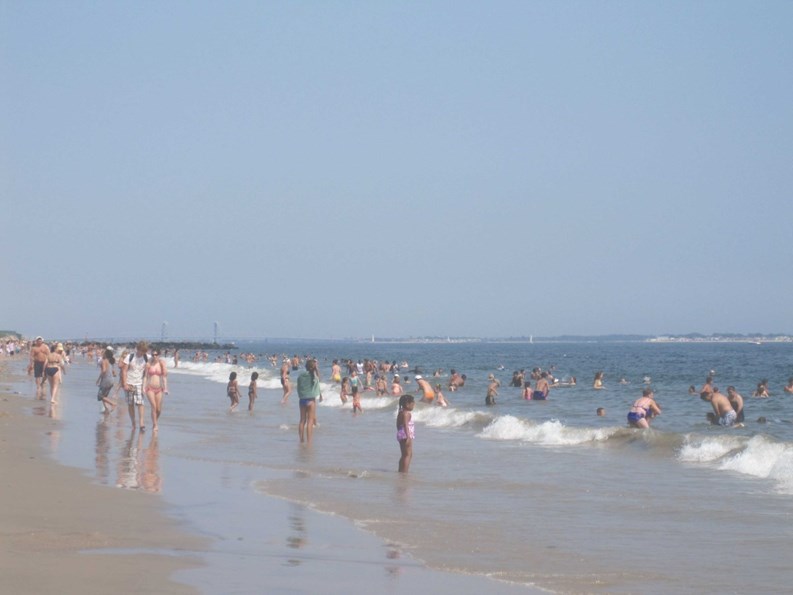You’ll find knishes, borscht, blinis, loads of shops, bakeries, fruits and vegetables, black market caviar and of course, vodka, along Brighton Beach Avenue, the neighborhood’s main artery that caters to a thriving Russian community. Day trippers from the five boroughs also make the trek (especially during the summer months) to this Brooklyn neighborhood along the Atlantic Ocean and nearby Coney Island’s amusement park.
Brighton Beach is bounded by Coney Island at Ocean Parkway to the west, Manhattan Beach at Corbin Place to the east, Gravesend at the Belt Parkway to the north and the Atlantic Ocean to the south.
Early History
Brighton Beach was founded by real estate developer William A. Engeman and named by Henry C. Murphy along with a group of entrepreneurs in an 1878 contest. The name was chosen because it evoked the memories of the English resort Brighton.
The center of Brighton Beach was Hotel Brighton, located at what now is the foot of Coney Island Avenue that was owned by Engeman. The hotel was popular with Manhattanites because it was easily reached from New York City via the Brooklyn Flatbush and Coney Island Railway, and distant enough to suggest a vacation.
The following year, The Brighton Beach Race Course opened next to the hotel and was headed by Engeman and the Brighton Beach Racing Association. The one-mile track was a smash hit with wealthy New Yorkers. A few of the track’s major events were the Brighton Derby for three-year olds and the Brighton Handicap that was open to older horses.
The Wild West
In 1883, William “Buffalo Bill” Cody galloped into Manhattan Beach with his re-creation of the cowboy life—complete with a band of Sioux Indians, Oklahoma cowgirls and Chief Bull Bear of the Cheyennes. Crowds flocked to see his show. In addition to Buffalo Bill’s show two vaudeville theaters presented various types of entertainment and The New Brighton Theatre promoted itself as being “the handsomest seaside theatre in the world.”
A mile long boardwalk opened in 1905 called The Brighton Pike. Visitors to the boardwalk could take in such attractions as Ferrari’s Wild Animal Arena, a carousel, an Irish fairground called Donnybrook Fair and Pawnee Bill’s Wild West Show and Great Far East Show that combined Wild West and Far East themes with elephants, camels and Russian Cossacks.
Two years later in 1907 Engeman created the two-story Brighton Beach Bathing Pavilion which accommodated 1,200 bathers. The members-only club boasted three pools, tennis, handball, miniature golf, mah-jong, card playing, high end entertainment and a nude beach.
When the New York Legislature passed the Hart-Agnew law in 1908 which banned gambling in New York state things began to change in Brighton Beach. The Brighton Beach Race Course, a thriving business, closed its doors. Then ten years later a massive fire destroyed the bathhouse and most of the attractions along the pike.
A Shore Attraction
During the years just before and after The Great Depression, the neighborhood attracted many first and second generation Jewish Americans where they went on to develop a rich cultural and religious presence. Their presence led to the conversion of the Brighton Beach Music Hall into a Yiddish Theater in 1918. The theater would house a stock company and present new plays, primarily musical comedies starring the best-known Yiddish actors in America.
In the 1920s a real estate developer built bungalows on site of the old racetrack and on the ocean front but with the extension of the Boardwalk land became too valuable for single-family housing so apartment house development began and shortly after Brighton Beach grew into a year-round neighborhood of families. In the 1930s and 1940s’ a huge influx of Jewish immigrants escaping fascism and Nazis arrived from Europe and landed in the area. This time period would provide the back drop for the Neil Simon play “Brighton Beach Memoirs,” which told the story of a fifteen year-old teenager coming of age in 1937 Brighton Beach. Throughout the 1950s and 1960s families migrated to the suburbs and the neighborhood became more elderly and impoverished and many homes were converted into single-room-occupancy dwellings for welfare families and patients released from mental institutions while many abandoned buildings were burned.
Little Odessa
In the 1970s the streets of Brighton Beach were lined with empty storefronts and dilapidated buildings but with the relaxation of the Soviet Union’s immigration policies thousands of Soviet Jews from the Ukraine settled into the area. When Russian immigrants began arriving and opening shops the area began to once again thrive and the neighborhood became known as “Little Odessa” after the port city on the Black Sea.
In 2006, Alec Brook-Krasny was elected for the 46th District of the New York State Assembly becoming the first elected Soviet-born Jewish politician from Brighton Beach.
Today, the area continues to have a large community of Jewish immigrants, who left the former Soviet Union as well as a large number of concentration camp survivors. As of 2011 of the estimated 55,000 Holocaust survivors living in New York City, most live in Brighton Beach.
The neighborhood is also a popular film destination. More recently, it has been used as a setting for New York television shows such as Law & Order, Blue Bloods, and Person of Interest. In August 2011, a reality TV series, Russian Dolls, followed the lives of eight women living in the community.
Christy Smith-Sloman is a staff writer for The Cooperator.





Leave a Comment